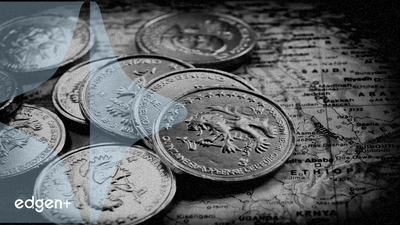Features
Trading Strategies
Resources
Ask AI About TRUMP

No Data Yet

## Executive Summary Asian stock markets experienced a sharp decline, with South Korea's KOSPI index triggering a circuit breaker following a substantial drop, and Japan's Nikkei 225 falling below the critical 50,000-point threshold. This market contraction was primarily driven by investor concerns regarding a potential "AI bubble" and broader market overvaluation. ## The Event in Detail The Korean stock market initiated a significant downturn, with the **KOSPI index** experiencing an over 6% drop and falling below the 4,000-point mark. This led to the **Korea Exchange** activating a circuit breaker on the KOSPI index after **KOSPI 200 futures** declined by 5%, resulting in a five-minute suspension of program trading. Concurrently, Japan's **Nikkei 225 index** dropped below 50,000 points for the first time since October 27, marking a 3.7% decrease. The sell-off was fueled by warnings from Wall Street regarding what is perceived as an overvalued market environment and heightened fears of an impending "AI bubble" burst. This recent decline contrasts with earlier performance where the KOSPI index had surged past 4,200 points to its strongest performance, reaching a historical high of 4,221.87 points towards the end of 2025. ## Market Implications The instability in traditional Asian equity markets had a direct and pronounced impact on the digital asset space. **Bitcoin's** price continued its losses, plunging below $106,000 and reaching a low of $103,768, marking a 3.2% loss over a 24-hour period. This price depreciation contributed to the removal of nearly **$70 billion** from the total cryptocurrency market value. The broader market sentiment in crypto is reflected by the **Crypto Fear & Greed Index**, which plummeted by 21 points to 21/100, signifying "Extreme Fear"—its lowest level since April. This indicates a significant increase in risk aversion across the cryptocurrency sector. Overall, the total crypto market capitalization decreased from **$4.22 trillion** to **$3.43 trillion**, effectively erasing all gains made since the start of 2025. ## Expert Commentary Market strategists and financial figures have been signaling caution regarding current market conditions. Esteemed investors like **Michael Burry** have reportedly been betting against Wall Street, while **Warren Buffett's** valuation gauge has reached record highs, collectively suggesting that financial markets may be entering a perilous phase. Crypto analyst **Ran Neuner** cautioned that even a minor pullback in equities could precipitate further losses in digital assets. In South Korea, **CryptoQuant CEO Ki Young Ju** highlighted a significant shift in investor behavior, suggesting that the South Korean government's policies might be aimed at redirecting speculative capital away from property and digital assets towards the stock market. This perspective aligns with observations of a dramatic decline in crypto trading volume in Korea. ## Broader Context The recent market dynamics underscore a divergence in South Korea's financial landscape. While the KOSPI index had previously achieved record highs, the country's crypto market has simultaneously experienced a significant downturn. Daily trading volume on South Korea's top five crypto exchanges plummeted by over 80%, from **KRW 17.1 trillion** to **KRW 3.2 trillion**. This substantial reduction in trading activity has led to the fading of the "Kimchi Premium," historically seen when cryptocurrencies trade at a higher price in South Korea compared to global markets. Analysts indicate that as traditional markets like the KOSPI ride high, everyday traders in South Korea appear to be returning to stocks, influenced by government efforts to mitigate speculation in alternative assets and by persistent, stringent regulations within the crypto industry.

## Executive Summary A new digital wallet, identified by the address **45fbE**, has completed a withdrawal of 421,100 **TRUMP** tokens from the **Binance** exchange. This transaction is valued at approximately **$3.05 million** and has been noted by on-chain analytics platforms, indicating a potential accumulation phase for the asset. ## The Event in Detail The specific on-chain activity involved wallet address **45fbE** moving **421,100 TRUMP** tokens from **Binance**. This withdrawal, quantified at approximately **$3.05 million**, was observed by on-chain analyst **The Data Nerd**. Such a substantial transfer from an exchange to a new, unidentified wallet often suggests a holder's intention to retain the asset rather than immediately sell, thereby reducing immediate selling pressure on the open market. ## Financial Mechanics and Strategic Implications The **TRUMP** token has demonstrated significant price volatility in its operational history. For instance, an event on June 3, 2025, saw an address associated with the **TRUMP** meme team transfer 4.167 million **TRUMP** tokens, then valued at approximately **$47 million**, to various cryptocurrency exchanges. This movement preceded a dramatic price decline, with the token experiencing a loss exceeding **90%** from its peak value, generating market concern over increased selling pressure and price instability. In contrast, the current withdrawal from **Binance** by a new wallet typically implies a different market dynamic, often interpreted as an an accumulation signal. Beyond these market movements, the **TRUMP** token is the subject of strategic development. **Fight Fight Fight LLC**, an entity associated with the token, is reportedly planning to acquire **Republic's U.S. business**. This potential acquisition aims to integrate the **TRUMP** token into crowdfunding and startup investing platforms, thereby broadening its utility beyond its current applications. This strategy aligns with a broader industry trend of embedding blockchain technology into traditional financial sectors and on-chain capital markets. The token's capacity for rapid value appreciation has been previously demonstrated, with one investor reportedly transforming a **$96 investment into over $3 million**. ## Market Implications and Broader Context The withdrawal of a substantial volume of **TRUMP** tokens from a major exchange carries implications for market sentiment and future price trajectory. While withdrawals from exchanges often signal reduced selling intent and potential price support, the historical volatility of the **TRUMP** token underscores the inherent risks associated with such assets. Large-scale transfers, whether to or from exchanges, frequently influence investor confidence and can amplify price movements due to perceptions of whale activity or strategic shifts. The ongoing efforts by **Fight Fight Fight LLC** to expand the token's utility through integration into crowdfunding platforms represent a strategic attempt to increase its fundamental value and reduce its reliance on speculative trading. Such initiatives contribute to the broader narrative of digital assets seeking tangible applications within the established financial ecosystem, although the speculative element of meme tokens remains a significant factor in their market behavior.

## Executive Summary Donut Labs has completed a $15 million seed funding round, bringing its total capital raised to $22 million, to advance its AI-powered crypto trading browser. ## The Event in Detail Donut Labs, the developer behind the AI-driven "Donut Browser," has concluded a seed funding round, securing an additional $15 million. This latest infusion of capital, contributed by investors such as **BITKRAFT, Makers Fund, Sky9 Capital, Altos Ventures, and Hack VC**, elevates the company's total funding to $22 million since its inception six months prior. The funding rounds have also seen participation from Sequoia China, HSG, MPCi, and key figures from the **Solana, Sui, and Monad** ecosystems, as well as core teams from **Jupiter, Drift, DeFi App, and Manifold Trading**. ## Financial Mechanics The total funding of $22 million for Donut Labs comprises both pre-seed and seed rounds. The initial pre-seed funding, reportedly $7 million, contributed to the firm's early development, with the recent $15 million seed round completing the total. This capital allocation is specifically designated to support engineering expansion and the advancement of AI model development for the Donut Browser platform. ## Business Strategy & Market Positioning Donut Labs' strategic objective is to revolutionize financial internet interactions by developing an "AI quant in the browser," as stated by CEO Chris Zhu. The Donut Browser is engineered to serve as an AI-powered "agent" that automates cryptocurrency trading, risk analysis, and on-chain strategy execution. It integrates features such as signal discovery, risk assessment, strategy generation, and on-chain execution. The browser is designed to interpret user intent and automate crypto transactions in real-time, featuring a built-in wallet, DEX integration, and dApp connectivity. Its AI capabilities are intended to screen risks, securely sign transactions, and minimize fees, making crypto more accessible. The company reports a waiting list exceeding 160,000 individuals, indicating substantial market interest in its offering. This strategy aligns with the growing trend of integrating AI-powered autonomous economic agents into the Web3 landscape to coordinate and execute complex actions across decentralized systems. ## Market Implications The successful funding of Donut Labs underscores the accelerating convergence of artificial intelligence and Web3 technologies, particularly in the realm of on-chain trading. This development could catalyze the adoption of AI-driven tools for cryptocurrency trading and strategy execution, potentially attracting new users and capital to the decentralized finance sector. The emergence of autonomous economic agents, capable of executing sophisticated trading strategies with precision, signifies a potential shift in how individuals and institutions interact with crypto markets. However, the proliferation of browser extensions, particularly those handling sensitive financial data, introduces security considerations. Historically, malicious cryptocurrency-themed browser extensions have led to significant financial losses due to vulnerabilities like intercepting private keys and transaction details. Donut Labs addresses these concerns through architecturally isolated signing environments and AI-powered risk screening, aiming to secure transactions while optimizing for speed and cost. ## Expert Commentary **Chris Zhu**, CEO of Donut Labs, commented on the browser's capabilities, stating, "Architecturally isolated signing environments and AI-powered risk screening secure every transaction while optimizing execution for speed and cost. AI translates opaque calldata into plain English and assigns safety grades." This emphasizes the company's focus on security and user-friendliness within the complex environment of blockchain transactions. ## Broader Context The investment in Donut Labs reflects a broader venture capital trend towards AI-agent-based Web3 platforms. Over $1.4 billion has been raised this year alone for such platforms, according to industry reports. This signifies a recognition of AI's potential to enhance and automate economic tasks within blockchain ecosystems. Donut Labs' "agentic" browser positions it as a key player in this evolving landscape, contributing to the development of a more efficient and automated Web3 economy by leveraging AI for tasks traditionally requiring significant manual intervention and expertise. The company's growth is indicative of the increasing demand for sophisticated tools that simplify and secure participation in the decentralized economy. Some industry observers also highlight the importance of new Web3 infrastructure standards, such as Coral Protocol, which are designed to enable AI agents to coordinate, communicate, and complete economic tasks securely and transparently across decentralized systems, further supporting the ecosystem Donut Browser operates within.

## Executive Summary HashKey Capital CEO **Deng Chao** asserts that maturing regulatory systems and professional infrastructure now present an optimal entry point for institutions into the crypto market, reflecting accelerating mainstream adoption and robust investment inflows. ## The Event in Detail During **Hong Kong Fintech Week**, **HashKey Capital** CEO **Deng Chao** articulated that the time is opportune for institutional participation in the crypto market. He emphasized the maturing nature of both regulatory systems and the underlying professional infrastructure as primary catalysts. HashKey Capital, which has managed institutional-grade funds since 2018, oversees over **US$1 billion** in client assets and recently closed its **Fund III** with **US$500 million** in commitments. This fund is designed to provide investors with exposure across various blockchain and crypto technologies. Deng Chao specifically noted the improving regulatory landscapes in **Hong Kong** and **Singapore**, positioning them as key regions fostering digital asset growth. A significant future trend identified by Deng Chao is the deep integration of **Real World Assets (RWA)** and **Digital Asset Treasury (DAT)**, underscoring blockchain's inherent capacity to carry value. ## Market Implications The pronouncements from **HashKey Capital** coincide with a period of accelerated institutional adoption and market maturity within the digital asset space. According to **Andreessen Horowitz's State of Crypto 2025** report, the industry achieved mainstream adoption in 2025, with traditional finance (TradFi) and fintech players intensifying their engagement. The report highlights that global crypto market capitalization surpassed **$4 trillion** for the first time, supported by a significant increase in active users, estimated between **40 million** and **70 million**. Further underscoring this trend, tokenized **Real-World Assets (RWA)** have experienced a substantial surge, growing by **260%** from **$8.6 billion** to over **$23 billion** in 2025. Private credit and **U.S. Treasury** debt constitute the majority of these tokenized assets, accounting for **58%** and **34%** respectively. Notably, **BlackRock's BUIDL** tokenized Treasury fund expanded from **$649 million** to **$2.9 billion**, representing an increase of nearly **350%**. This growth signals increasing investor confidence and demand for regulated, digitally native financial products. ## Expert Commentary Industry analysis consistently points to robust regulatory frameworks as a critical factor driving institutional confidence. The **European Union's Markets in Crypto-Assets Regulation (MiCAR)**, fully operational since January 2025, provides a unified regulatory approach that fosters innovation and investor protection. Similarly, **Hong Kong** is actively easing rules to encourage crypto trading, with the **Securities and Futures Commission (SFC)** finalizing licensing rules for dealers and custodians. The city's central bank is also slated to issue the first licenses for stablecoin issuers in 2025, alongside allowing licensed crypto trading platforms to connect local entities with global order books. These regulatory advancements are perceived as signals that digital assets are establishing a permanent presence in the financial landscape. ## Broader Context The acceleration of institutional engagement is profoundly reshaping the global financial ecosystem. Institutional crypto adoption is expected to continue with measured integration, leading to enhanced market stability and liquidity. The success of **Bitcoin** and **Ethereum** spot **ETFs** has set a precedent, potentially paving the way for approvals of other single-token ETFs, such as those for **Solana** or **XRP**. Projections indicate that institutional holdings of **Bitcoin** could reach **$414 billion** by August 2025, potentially shifting the ownership landscape from retail to institutional dominance. The launch of **Ethereum** spot ETFs in July 2024 injected over **$12 billion** in institutional capital by August 2025, with total net assets reaching **$18.37 billion**. By October 2025, **Bitcoin** surged past **$120,000**, briefly touching **$126,000**, driven by a significant demand-supply gap exacerbated by **ETFs** like **BlackRock's iShares Bitcoin Trust (IBIT)** accumulating vast amounts of **BTC**. The fundamental relationship between **blockchain** and **Web3**, emphasizing decentralization and digital ownership, remains a core driver for this long-term shift towards a more open and user-centric internet, with cryptocurrencies facilitating value transfer and network participation.